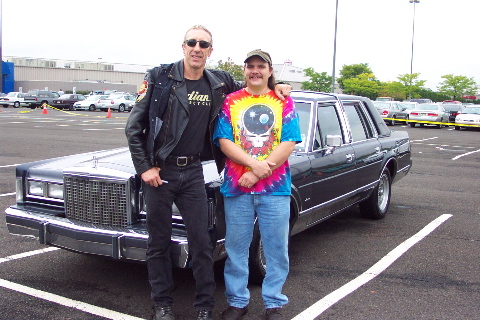I posted this in a dead thread - and since I put some time and effort into writing this I'll post I thought I'd post it where someone might read it.
have done numerous stereo installations that other people have paid me to do. I'm not saying that I am a pro - I'm not. I would just like to offer some advice.
I think that the best quality headunits are
Kenwood Excelon
Most Pioneer models
Most Alpines
When you choose a headunit , try to pick one with MOSFET circuitry.
For wiring the speakers 18 gauge is sufficient - unless you will be powering your speakers with an amplifier. In that case use 14 gauge. My preference is running speakers off of the headunit and not an amp.
That brings me to a VERY important point - another member said that a speaker with higher power handling capacity does not necessarily sound better - and he is sooooo right.
Too many people think "ok , i'll get these 200 watt 6x9's and they will kick ass" . These high watt speakers are designed for use with an amplifier, not soley the headunit.
If your headunit has for instance 50x4 watt - this translates into 25 watts rms power per channel. A 200 watt 6x9 has about 100 watt rms. (usaully rms - continous power- is half of max). When you have a 100 watt rms speaker connected to a headunit pushing 25 watts rms - the speaker is not going to sound anywhere near as good as it SHOULD -. In this situation - when you crank the volume all the way up - it's not the speakers distorting , it's actually the signal from the headunit. Plus, underpowering speakers can damage them. It's worse for a speaker to be underpowered than overpowered.
Kicker , Pioneer and JVC to name a few all have low watt speakers available that when hooked up to just the head unit will sound great. Power matching is the name of the game.
Another factor to consider when picking speakers is the frequency response range. Usually a speaker with a broader speaker response is a better sounding speaker - not that you can hear 20hz or 22khz anyway .
If you are trying to put together a stereo that has good overall sound without an amp and sub ect..... I'd recommend sticking with 6x9s. A good way to make the 6x9 sound better instead of mounting the speaker under the rear deck like the factory does - cut a hole for the speaker in the deck lid and install the speaker there. You will hear quite a bit more bass and less distortion - they won't sound muddy and muffled anymore.6x9's have more bass than a 6.5 but aren't quite as clear. So what though - that 's why you buy some good dash or door speakers. That's where i'd recommend a pair of MB Quarts. As for getting bigger speakers in the front --don't. Go with a higher quality stock size speaker. The idea is front stage --rear fill. The human ear can't discern whether bass notes are coming from front or rear.
If you are going for a killer sound system then that's where you get the MB Quarts in the front - some sony mobile es 6.5's in the rear, a 1500 watt class D amp pumpin one Orion H2 10" sub in the trunk ( all running off of a Kenwood Excelon head unit).
Hope some of this helped somone.
have done numerous stereo installations that other people have paid me to do. I'm not saying that I am a pro - I'm not. I would just like to offer some advice.
I think that the best quality headunits are
Kenwood Excelon
Most Pioneer models
Most Alpines
When you choose a headunit , try to pick one with MOSFET circuitry.
For wiring the speakers 18 gauge is sufficient - unless you will be powering your speakers with an amplifier. In that case use 14 gauge. My preference is running speakers off of the headunit and not an amp.
That brings me to a VERY important point - another member said that a speaker with higher power handling capacity does not necessarily sound better - and he is sooooo right.
Too many people think "ok , i'll get these 200 watt 6x9's and they will kick ass" . These high watt speakers are designed for use with an amplifier, not soley the headunit.
If your headunit has for instance 50x4 watt - this translates into 25 watts rms power per channel. A 200 watt 6x9 has about 100 watt rms. (usaully rms - continous power- is half of max). When you have a 100 watt rms speaker connected to a headunit pushing 25 watts rms - the speaker is not going to sound anywhere near as good as it SHOULD -. In this situation - when you crank the volume all the way up - it's not the speakers distorting , it's actually the signal from the headunit. Plus, underpowering speakers can damage them. It's worse for a speaker to be underpowered than overpowered.
Kicker , Pioneer and JVC to name a few all have low watt speakers available that when hooked up to just the head unit will sound great. Power matching is the name of the game.
Another factor to consider when picking speakers is the frequency response range. Usually a speaker with a broader speaker response is a better sounding speaker - not that you can hear 20hz or 22khz anyway .
If you are trying to put together a stereo that has good overall sound without an amp and sub ect..... I'd recommend sticking with 6x9s. A good way to make the 6x9 sound better instead of mounting the speaker under the rear deck like the factory does - cut a hole for the speaker in the deck lid and install the speaker there. You will hear quite a bit more bass and less distortion - they won't sound muddy and muffled anymore.6x9's have more bass than a 6.5 but aren't quite as clear. So what though - that 's why you buy some good dash or door speakers. That's where i'd recommend a pair of MB Quarts. As for getting bigger speakers in the front --don't. Go with a higher quality stock size speaker. The idea is front stage --rear fill. The human ear can't discern whether bass notes are coming from front or rear.
If you are going for a killer sound system then that's where you get the MB Quarts in the front - some sony mobile es 6.5's in the rear, a 1500 watt class D amp pumpin one Orion H2 10" sub in the trunk ( all running off of a Kenwood Excelon head unit).
Hope some of this helped somone.

 :slug: :banana: :rock:
:slug: :banana: :rock:  :rock:
:rock:  :rock: :rock: :jumpin: :banana:
:rock: :rock: :jumpin: :banana: 





 I work about 14 hours a day ( truck driver locally) if you email me your phone number or have some way that I can get ahold of you we can work out when we can meet. What all needs to be installed?
I work about 14 hours a day ( truck driver locally) if you email me your phone number or have some way that I can get ahold of you we can work out when we can meet. What all needs to be installed? 
Comment